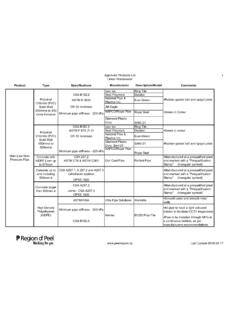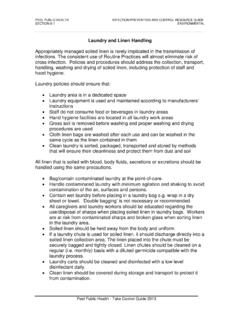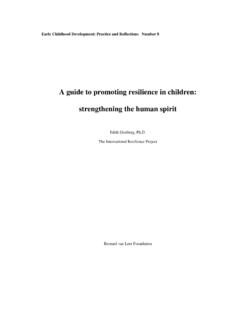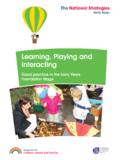Transcription of What are Effective Interventions for Building Resilience ...
1 What are Effective Interventions for Building Resilience among At Risk Youth? Karen LeMoine, Analyst, Research and Policy Judy Labelle, Manager Community Health Initiatives Strategic Policy, Planning and Initiatives Health Services October, 2014. Table of Contents Key 1. Executive Summary .. 2. 1 Issue .. 5. 2 6. 3 Definition of Resilience .. 6. 4 Literature Review Question .. 7. 5 Literature Search .. 7. 6 Relevance Assessment .. 8. 7 Search Results .. 8. 8 Critical Appraisal .. 8. 9 Description of Included Studies.
2 9. 10 Synthesis of Findings .. 11. 11 Applicability and Transferability..17. 12 Recommendations .. 20. References .. 22. Appendices .. 24. Appendix A: An Ecological Understanding of Resilience .25. Appendix B: Stepping Up Strategic Framework for Ontario's Youth .. 26. Appendix C: Search Strategy .. 27. Appendix D: Literature Search Flowchart .. 33. Appendix E: Data Extraction Tables ..34. Appendix F: Applicability & Transferability ..40. i Key Messages 1. Efforts to build Resilience in youth should focus on the environment and systems surrounding youth.
3 Resilience should not be thought of or portrayed as an individual characteristic. 2. Use terminology such as marginalized youth , youth with multiple barriers or youth in challenging contexts as opposed to at-risk youth . This supports the shift in identifying solutions beyond the individual level to the broader environment and system. 3. The following components can be built into strategies and initiatives that intend to build Resilience in youth: Build upon youth's social, emotional and personal competence skills.
4 Promote self-efficacy of youth through helping them to define their own outcomes and involving them in the development of services they receive. Offering parenting programs that include family-centered concepts such as positive parenting, family management, bonding and parent-child communications. Ensuring that each youth served has at least one secure relationship with an adult caregiver that is predictable and stable. Supporting youth in their ability to build social capital and connectedness with resources in their community.
5 4. There is limited empirical evidence of the effectiveness of Resilience Building Interventions at the community or systems level. More research and evaluation is required for determining effectiveness and impact. 1. Executive Summary Research Question What are Effective Interventions for Building Resilience among at-risk youth? Context A subset of Peel's youth population are growing up in circumstances that challenge their ability to stay on a positive life-course trajectory into adulthood ( are at-risk). For example, 16% of Peel children under the age of 18 live in a low income household (5); 5,655 dependent children accessed an emergency or victims of family violence shelter in Peel in 2012 (6); and Peel Children's Aid Society provided care for 926 children in 2012 and investigated 7,217.
6 Reports of child abuse and neglect (7). By focusing on prevention and Building Resilience among these youth, costs to the health care, justice, child protection and social assistance systems can be minimized in the future. The Community Health Initiatives Team (CHI team) in Health Services collaborates with and supports youth organizations in Peel Region that strive to prevent youth violence and build Resilience among at-risk youth. Methods and Results A search of both the academic and grey literature yielded 91 results.
7 Of these results, 89. were excluded based on primary and secondary relevance assessment. The remaining practice guide and literature review were appraised as moderate quality and were included in this rapid review. There are limitations to the application of these findings due to the lack of empirical evidence of effectiveness reported in the literature review and practice guide. Synthesis of Key Findings Evidence from the practice guide and the literature review identified themes common to Interventions and Resilience -enhancing factors at the individual, family and community levels.
8 2. At the individual level, Interventions focused on Building the child or adolescent's social, emotional or personal competence were efficacious for Building Resilience . For the specific at- risk group of youth in foster care, helping them to define their own outcomes and contribute to the development of the services they receive can build self-esteem and self-efficacy, and in turn build Resilience . At the family level, having a stable emotional connection and a predictable relationship with an adult caregiver are strong predictors of positive adolescent outcomes.
9 Effective Interventions included family-centered concepts such as positive parenting training, family management, bonding and parent-child communications. At the community level, fostering connectedness with community resources and people in one's neighbourhood can build collective Resilience beyond individual and family factors. Three types of promising strategies for Building Resilience at the community level are suggested: Building social capital, service learning, and organized community youth activities. Conclusion and Recommendations Based on the rapid review findings and a discussion with team members and external community partners to assess the applicability and transferability of the evidence, the Community Health Initiatives Team should take the following actions: 1.
10 Share knowledge with youth-serving community organizations in Peel about the nature and scope of Resilience and its influence on positive outcomes for at-risk youth. Current theoretical views on Resilience points towards the adaptation of the environment and systems surrounding youth, as opposed to changes at the individual level. Resilience should not be thought of or portrayed as an individual characteristic. 3. 2. Move away from using the term at-risk youth in the CHI Team's continued efforts to support youth-serving organizations.
















